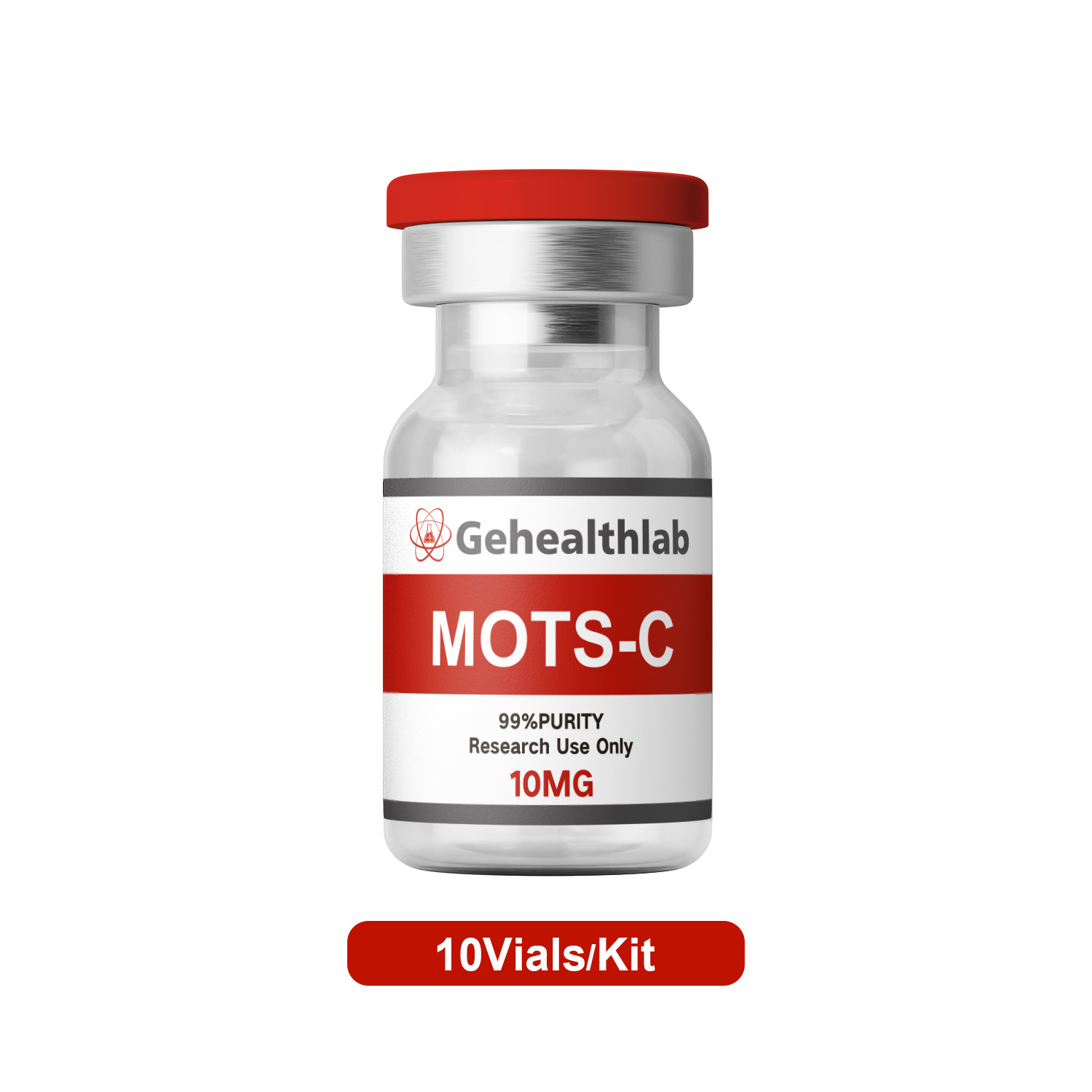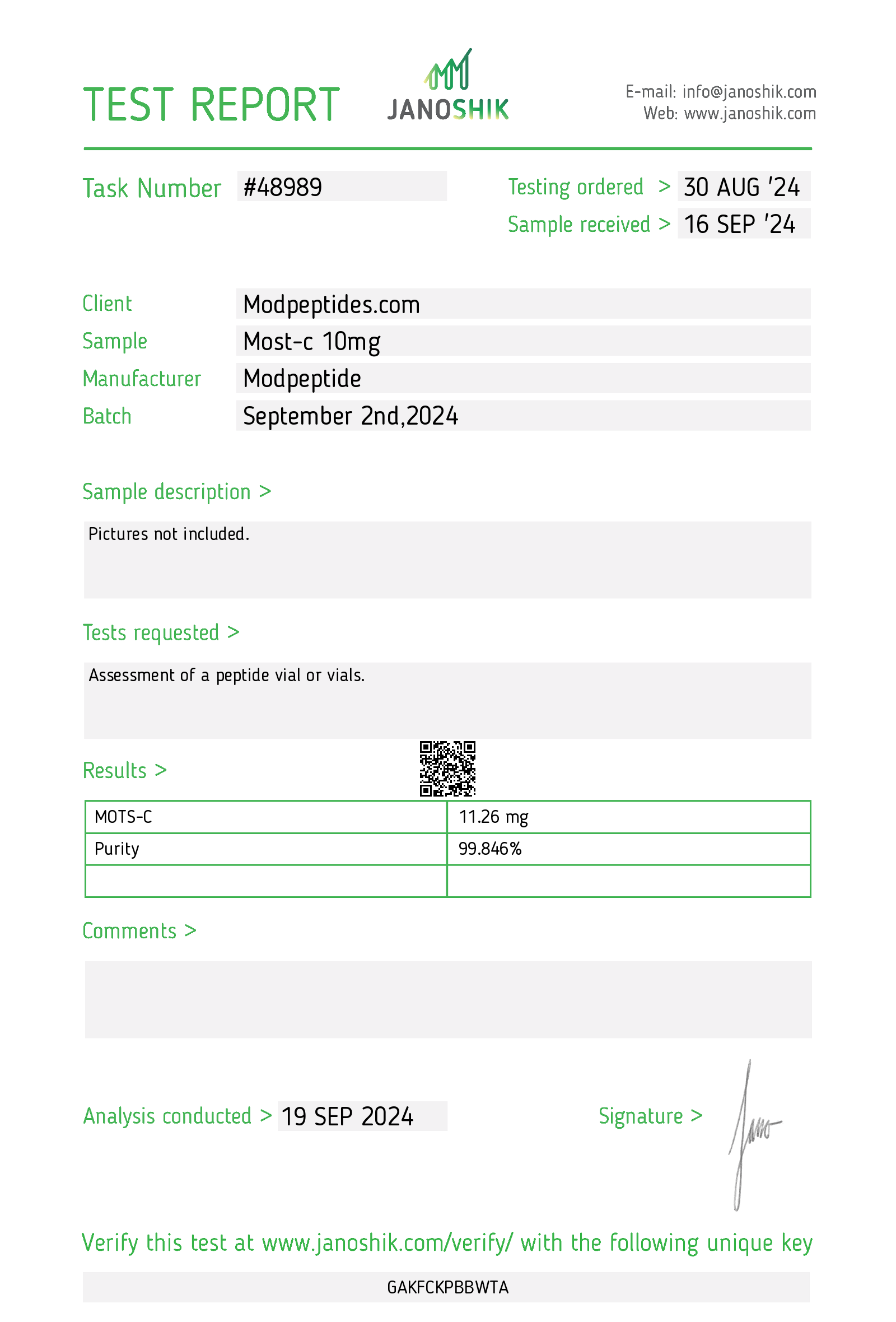10mg*10 vials each kit
MOTS-C 10mg*10 vials
The price is for one kit, including 10 vials
Each vial contains 10mg, 10 vials each kit
Purity 99%
Remark: product not including labels when shipping
Each vial contains 10mg, 10 vials each kit
Purity 99%
Remark: product not including labels when shipping
Quantity
-
DetailWhat's Mots-C?
MOTS-c (mitochondrial open-reading-frame of the 12S rRNA-c) peptide is a novel mitochondria-derived peptide. It is a short peptide composed of 16 amino acids, expressed in tissues and plasma, indicating a cell-specific and hormonal role.With the potential to work both as a cell-specific compound and as a hormone, this peptide possibly acts by stimulating the AMP-activated protein kinase (AMPK) pathway. Only two mitochondrial-derived peptides (MDPs) have been studied, Humanin and MOTS-c. When metabolic stress occurs in the organism, the peptide is believed to translocate to the cellular nuclei and alter the gene expression. MOTS-c peptide may also be released extracellularly and is known as "mitochondrial hormone" or simply as "mitokine.”
MOTS-c Peptide and Muscle MetabolismWith increasing age, skeletal muscles tend to gain insulin resistance, leading to decreased glucose uptake. Upon peptide exposure, skeletal muscles may be stimulated with an improved response toward AMPK activation. As a result, glucose transporter expression may increase, potentially improving skeletal muscle metabolism and enhancing skeletal muscle functioning and growth. Further, MOTS-c's actions are posited to include targeting metabolic pathways such as the folate-methionine cycle and purine biosynthesis. This targeting may potentially lead to a modulation of cellular metabolism, including actions on glucose uptake and lipid utilization. The peptide's impact might involve a shift in metabolic priorities within the cell, possibly affecting the balance between anabolic and catabolic processes. In systemic metabolism, MOTS-c is posited to function as a mitochondrial hormone, with circulating peptide levels appearing to affect metabolic functions in skeletal muscle and possibly adipose tissue. Its potential regulatory actions on glucose homeostasis and insulin action suggest a broader hormonal role in energy balance and nutrient sensing across different tissues.MOTS-c Peptide and Fat Cell MetabolismResearch has suggested that the peptide may potentially leave the mitochondrial site, translocate to cellular nuclei, and possibly alter gene expression. More specifically, the peptide may interact with a broad range of genes, particularly those with antioxidant response elements (ARE), hinting at a potential regulatory relationship with stress-responsive transcription factors like NRF2. Such findings suggest a genetically integrated system of mitonuclear communication, where both mitochondrial and nuclear genomes may encode factors that cross-regulate each other. This action, in turn, may alter glucose uptake restriction.This hypothesis was first suggested from a study in which the experimental mice were given high-fat food, and only half were presented with the peptide. The researchers indicated that MOTS-c may potentially impact cellular metabolism by inhibiting the folate cycle directly tethered de novo purine biosynthesis, consequently leading to AMPK activation. Such actions hint at a broader role of the peptide in regulating insulin sensitivity and metabolic homeostasis, offering insights into its preventive potential against age-dependent and high-fat-induced insulin resistance and diet-induced obesity. The study presents supportive data to suggest that the peptide may stimulate glucose utilization, affect the methionine-folate cycle, and promote AMPK activation. These cellular actions suggest that MOTS-c might coordinate various metabolic processes, including glucose and lipid metabolism. Consequently, the murine models exposed to the peptide were lean and more energetic than the rest, further indicating that the peptide might prevent fat accumulation and induce glucose uptake via the AMPK pathway.MOTS-c Peptide and BoneMOTS-c peptide has been suggested to regulate the transforming growth factor beta (TGF-beta)/SMAD pathway, which may profoundly affect bone tissues.More specifically, MOTS-c's actions may involve the upregulation of TGF-β/Smad pathway-related genes, including TGF-β1, TGF-β2, and Smad7, suggesting a pivotal role of this pathway in MOTS-c mediated osteogenic differentiation. This hypothesis is further supported when the osteogenic differentiation promoted by MOTS-c is reversed upon TGF-β1 knockdown, indicating that MOTS-c's actions may be at least partly mediated through the TGF-β/Smad pathway. The peptide may also stimulate the expression of osteogenesis-related genes such as ALP, Bglap, and Runx2. Thus, this peptide may stimulate the SMAD pathway in the osteoblast cells, possibly improving bone density and strength. When studied in bone marrow cells, this compound appeared to trigger the differentiation of the stem cells, which may lead to bone tissue development. -
Customer ReviewsNo comments


